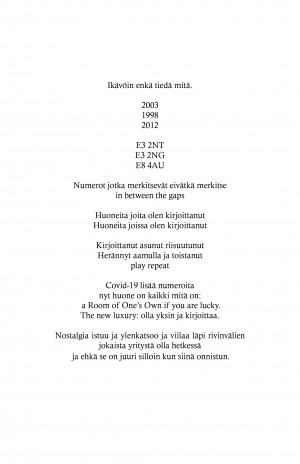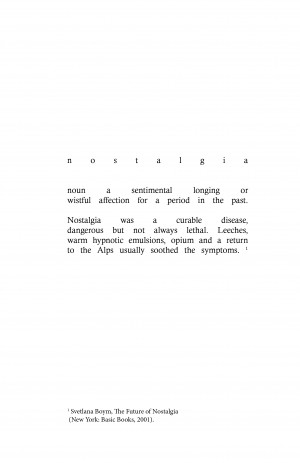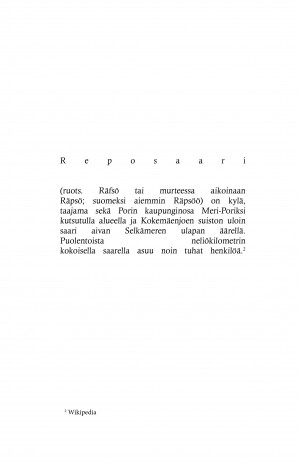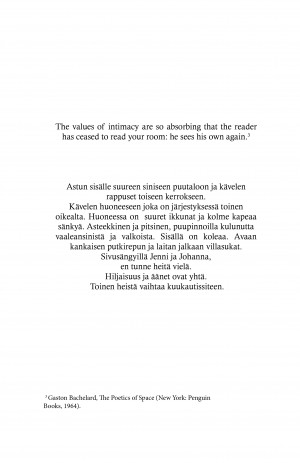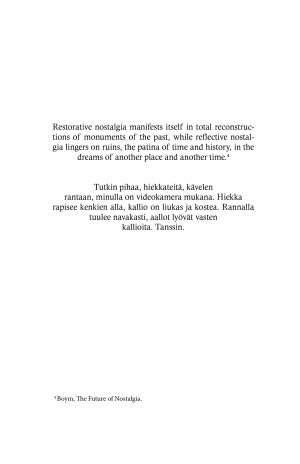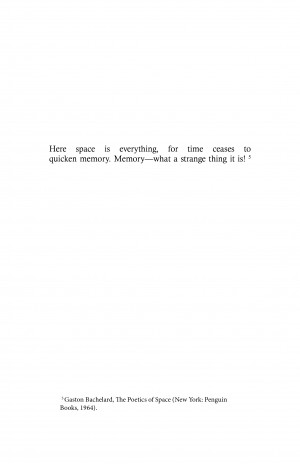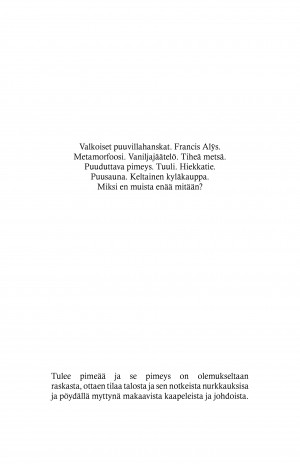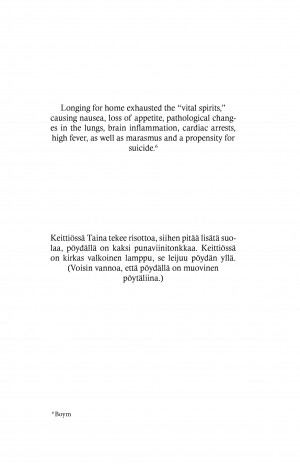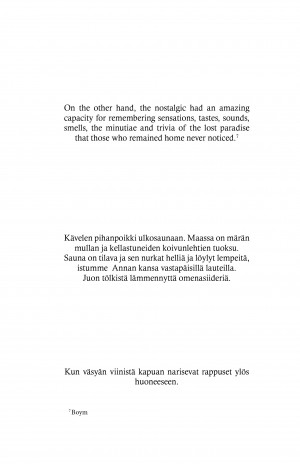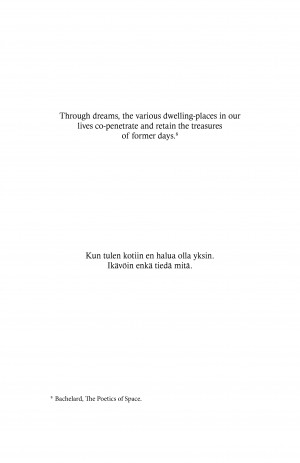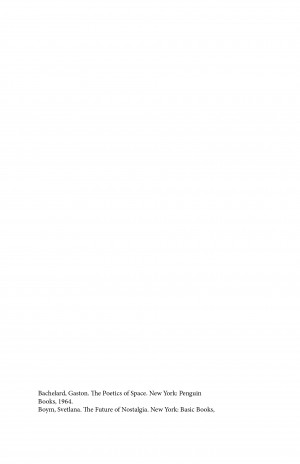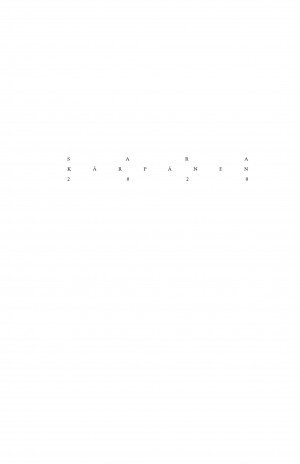SIESTA 1955-98 NEVER FORGET

Not
to
Sing
Like
a
City
Bird
Sings



’Huoneita joita kirjoitan / Huoneista joissa kirjoitan’ is a written text and poetic exploration focusing on nostalgia attached to physical sites and spaces. To what extent does our memory betray us? In what ways do we re-write our own memories, what do we take in what do we leave out? The text explores the white paper as a site, and tests its limitations to hold and create a space that is both private and public, shared and intimate. The text is accompanied with excerpts of space and nostalgia by Svetlana Boym and Gaston Bachelard.
Sara Kärpänen is a writer and visual artist (MA) exploring the lines between private and public in her work by using poetry, photography and audio as her main mediums. Sara lives and works in London where she is currently finishing a Master’s Degree at the UCL, Bartlett School of Architecture. Sara has worked with Finnish and international publications, cultural organizations and architect practices. She’s currently writing a book on how to occupy public space through art and cultural activism, funded by the Kone Foundation.
HUONEET JOITA KIRJOITAN HUONEET JOISSA KIRJOITAN
THE ROOMS THAT I WRITE THE ROOMS WHERE I WRITE
Ikävöin enkä tiedä mitä.
2003
1998
2012
E3 2NT E3 2NG E8 4AU
Numerot jotka merkitsevät eivätkä merkitse in between the gaps
Huoneita joita olen kirjoittanut Huoneita joissa olen kirjoittanut
Kirjoittanut asunut riisuutunut Herännyt aamulla ja toistanut play repeat
Covid-19 lisää numeroita
nyt huone on kaikki mitä on:
a Room of One’s Own if you are lucky. The new luxury: olla yksin ja kirjoittaa.
Nostalgia istuu ja ylenkatsoo ja viilaa läpi rivinvälien jokaista yritystä olla hetkessä
ja ehkä se on juuri silloin kun siinä onnistun.
nostalgia
noun a sentimental longing or wistful affection for a period in the past.
Nostalgia was a curable disease, dangerous but not always lethal. Leeches, warm hypnotic emulsions, opium and a return to the Alps usually soothed the symptoms. 1
Reposaari
(ruots. Räfsö tai murteessa aikoinaan Räpsö; suomeksi aiemmin Räpsöö) on kylä, taajama sekä Porin kaupunginosa Meri-Poriksi kutsutulla alueella ja Kokemäenjoen suiston uloin saari aivan Selkämeren ulapan äärellä. Puolentoista neliökilometrin kokoisella saarella asuu noin tuhat henkilöä.2
1 Svetlana Boym, The Future of Nostalgia (New York: Basic Books, 2001).
2 Wikipedia
The values of intimacy are so absorbing that the reader has ceased to read your room: he sees his own again.3
Astun sisälle suureen siniseen puutaloon ja kävelen rappuset toiseen kerrokseen.
Kävelen huoneeseen joka on järjestyksessä toinen oikealta. Huoneessa on suuret ikkunat ja kolme kapeaa sänkyä. Asteekkinen ja pitsinen, puupinnoilla kulunutta vaaleansinistä ja valkoista. Sisällä on koleaa. Avaan kankaisen putkirepun ja laitan jalkaan villasukat. Sivusängyillä Jenni ja Johanna,
en tunne heitä vielä.
Hiljaisuus ja äänet ovat yhtä.
Toinen heistä vaihtaa kuukautissiteen.
Restorative nostalgia manifests itself in total reconstruc- tions of monuments of the past, while reflective nostal- gia lingers on ruins, the patina of time and history, in the dreams of another place and another time.4
Tutkin pihaa, hiekkateitä, kävelen
rantaan, minulla on videokamera mukana. Hiekka rapisee kenkien alla, kallio on liukas ja kostea. Rannalla tuulee navakasti, aallot lyövät vasten
kallioita. Tanssin.
3 Gaston Bachelard, The Poetics of Space (New York: Penguin Books, 1964).
4 Boym, The Future of Nostalgia.
Here space is everything, for time ceases to quicken memory. Memory—what a strange thing it is! 5
Valkoiset puuvillahanskat. Francis Alÿs. Metamorfoosi. Vaniljajäätelö. Tiheä metsä. Puuduttava pimeys. Tuuli. Hiekkatie. Puusauna. Keltainen kyläkauppa. Miksi en muista enää mitään?
5 Gaston Bachelard, The Poetics of Space (New York: Penguin Books, 1964).
Tulee pimeää ja se pimeys on olemukseltaan raskasta, ottaen tilaa talosta ja sen notkeista nurkkauksisa ja pöydällä myttynä makaavista kaapeleista ja johdoista.
Longing for home exhausted the “vital spirits,” causing nausea, loss of appetite, pathological chang- es in the lungs, brain inflammation, cardiac arrests, high fever, as well as marasmus and a propensity for suicide.6
On the other hand, the nostalgic had an amazing capacity for remembering sensations, tastes, sounds, smells, the minutiae and trivia of the lost paradise that those who remained home never noticed.7
Keittiössä Taina tekee risottoa, siihen pitää lisätä suo- laa, pöydällä on kaksi punaviinitonkkaa. Keittiössä on kirkas valkoinen lamppu, se leijuu pöydän yllä. (Voisin vannoa, että pöydällä on muovinen pöytäliina.)
Kävelen pihanpoikki ulkosaunaan. Maassa on märän mullan ja kellastuneiden koivunlehtien tuoksu. Sauna on tilava ja sen nurkat helliä ja löylyt lempeitä, istumme Annan kansa vastapäisillä lauteilla. Juon tölkistä lämmennyttä omenasiideriä.
6 Boym
Kun väsyän viinistä kapuan narisevat rappuset ylös huoneeseen.
7 Boym
Through dreams, the various dwelling-places in our lives co-penetrate and retain the treasures
of former days.8
Kun tulen kotiin en halua olla yksin. Ikävöin enkä tiedä mitä.
8 Bachelard, The Poetics of Space.
Bachelard, Gaston. The Poetics of Space. New York: Penguin Books, 1964.
Boym, Svetlana. The Future of Nostalgia. New York: Basic Books,
SARA KÄRPÄNEN 2020

